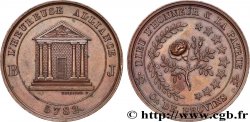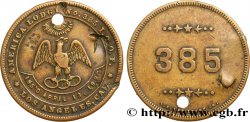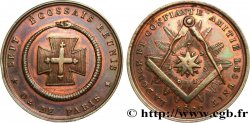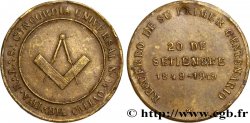fjt_533646 - FREEMASONRY LOGE CONCORDIA UNIVERSAL N°14 CALLAO, Centenaire 1848-1949 n.d.
70.00 €约 568.40 CNY
数量
加入购物车

种类 LOGE CONCORDIA UNIVERSAL N°14 CALLAO, Centenaire 1848-1949
日期: n.d.
材质 copper
直径 30 mm
模子方针 12 h.
重量 10 g.
侧面 Lisse
出版目录中的项代码 :
家谱
Exemplaire provenant de la Collection JCT
正面
正面的文字 R :. L :. S :. CONCORDIA UNIVERSAL N°14 / VALL :. DEL CALLAO /.
正面的说明书 Équerre et compas entrecroisés.
背面
背面的文字 RECUERDO DE SU PRIMER CENTENARIO.
背面的说明书 sur trois lignes ; 20 DE / SETIEMBRE / 1849 - 1949.
评论
La franc-maçonnerie est apparue au Pérou avec les guerres de l’indépendance. La première loge, Paz y Perfecta Union, eut en 1821 José de San martin parmi ses fondateurs, quand il entra à Lima en libérateur. La naissance d’autres loges suivit ses victoires et celles du frère Antonio José de Sucre. En 1830, fut constitué un Suprême Conseil et l’année suivante la première Grande Loge du Pérou. En 1833, le pouvoir passa aux mains des militaires hostiles à la franc-maçonnerie et les loges furent fermées jusqu’en 1845. En 1852, un nouveau Grand orient national fut fondé, mais en 1858 une scission eut pour conséquence la constitution de la Grande Loge Nationale du Pérou. En 1860, un nouveau schisme éclata. Grande Loge et Grand Orient disparurent. En 1882 enfin a été constituée la grande Loge des francsmaçons Anciens, Libres et Acceptés du Pérou, qui existe encore actuellement. Elle compte une centaine de loges. A coté d’elle, continue à exister le Suprême Conseil du Rite Ecossais..








 对产品描述纠错
对产品描述纠错 打印
打印 分享我的选择
分享我的选择 提问
提问 Consign / sell
Consign / sell
 产品介绍
产品介绍











